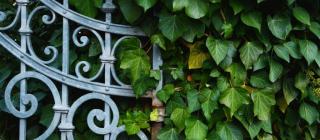

Ivy, whether outdoors or indoors, is a climbing or covering vine that is sometimes invasive…
Important Ivy facts
Name – Hedera helix
Family – Araliaceae
Type – climbing vine
Height – 16 to 65 feet (5 to 20 m)
Exposure – full sun, part sun, shade
Soil – ordinary
Foliage – evergreen
Caring for ivy is easy since it adapts to all types of soil and pleases itself most anywhere.
Favor planting in fall or spring and avoid freezing temperatures.
Water abundantly especially at the beginning.
Let the ivy climb both as ground and wall cover.
You can trim it easily if it grows too large, and this doesn’t alter its growth.
 The main appeal of ivy is in its reliable, hardy evergreen leafage. It’s a favorite to create a deep green backdrop against which other colorful plants can stand out.
The main appeal of ivy is in its reliable, hardy evergreen leafage. It’s a favorite to create a deep green backdrop against which other colorful plants can stand out.
There are scores of ways to use it, from the usual wall-covering to smother an otherwise ugly surface, to setting up along fences and tunnels.
Archways and sculptures made of wrought iron are always stunning when paired with lush, green ivy. It’s as if the emerald colors of the vine and the sheer brute force of iron and steel make each other feel alive.
 Illustrious on ancient manors, ivy is an excellent wall cover that can grow to unfathomable sizes.
Illustrious on ancient manors, ivy is an excellent wall cover that can grow to unfathomable sizes.
Hardy and rather fast-growing, it will reach a point where getting rid of it will be a real challenge… Cutting off large stems and consistently removing any new shoots immediately will wear the plant out over about two years.
Grow ivy as an addition to an indoor living plant wall. Slow growth and thick leaves will ensure a lot of greenery!
Best is to grow it in suspensions or garden boxes to keep it under control.
Take care because ivy can damage walls, especially if they’re old and friable. Roots thread their way between bricks and stones and disjoint them.